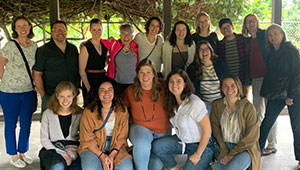Erin Bowles, MPH
Biography
Epidemiologist Erin Bowles, MPH, is looking at breast cancer screening and treatment from many different perspectives. Her research brings new insight into cancer risk factors, diagnosis, treatment, and survivorship, while helping improve cancer care for patients and families.
Erin received an R50 mid-career research award from the National Cancer Institute (NCI). This award is given to cancer researchers who have demonstrated successes and contributions to cancer research as a non-principal investigator. As a key member of 2 large cancer collaborations — the NCI's Breast Cancer Surveillance Consortium and the Kaiser Permanente Breast Cancer Survivors Cohort — Erin has developed diverse expertise that includes reading mammograms for breast density and using administrative data to understand patterns of breast cancer screening and cancer treatment.
Her current work includes:
- Collaborating on a multi-site study with investigators from Memorial Sloan Kettering Cancer Center, Kaiser Permanente Northern California, and Rutgers University to understand how obesity affects chemotherapy treatment dosing and risks of recurrence and toxicity in women with breast cancer
- Helping investigators from Kaiser Permanente Northern California and the University of California (UC) San Francisco and UC Davis understand imaging trends in children and pregnant women, and subsequent risks of leukemia associated with ionizing radiation from imaging exams
- Working with investigators from the NCI, Kaiser Permanente Colorado, Kaiser Permanente Georgia, and Kaiser Permanente Hawaii to study how mammographic breast density, radiation treatment, and tissue biomarkers are associated with second cancers in women with previous breast cancer
- Collaborating on several studies within the BCSC to understand how disparities, access to advanced technology like artificial intelligence, and social drivers of health affect breast cancer screening, diagnosis, and surveillance
- Working with teams from the Centers for Disease Control and Prevention, University of Washington, Henry Ford Health System, and Multicare Health System to develop and validate questions about cancer screening for people eligible for breast, colorectal, cervical, and/or lung cancer screening for the National Health Interview Survey.
Erin’s experience working with large observational cohorts and collaborations with numerous study teams over the past 20+ years has provided her with expertise in data collection and quality control for many subject areas. She is also Director of the Collaborative Science Division at KPWHRI, providing leadership, supervision, mentorship, and support to collaborative scientists with a range of skills and expertise. She is passionate about providing long-term career paths for masters- and PhD-level scientists who don’t want to become independent investigators.
Research interests and experience
-
Cancer
Breast cancer; colorectal cancer; multiple myeloma; thyroid cancer; pancreatic cancer; biostatistics; epidemiology; mammography; mammographic breast density; cancer treatment; cancer screening and surveillance; automated data collection; quality of care; medication use; care coordination; administrative data
-
Health Services & Economics
Access to care; health disparities; health outcomes research; quality of life; measurement of change in health care systems; practice variation
-
Women's Health
Menopause; hormone replacement therapy (HRT); breast cancer
-
Aging & Geriatrics
Cognitive health and dementia; biostatistics; epidemiology; medication use; cancer
-
Medication Use & Patient Safety
Pharmacoepidemiology; observational study research methods; chemotherapy; radiation exposure
Recent publications
Welsh ML, Buist DS, Aiello Bowles EJ, Anderson ML, Elmore JG, Li CI. Population-based estimates of the relation between breast cancer risk, tumor subtype, and family history. Breast Cancer Res Treat. 2009 Apr;114(3):549-58. Epub 2008 Apr 25. PubMed
Atkinson C, Newton KM, Bowles EJ, Yong M, Lampe JW. Demographic, anthropometric, and lifestyle factors and dietary intakes in relation to daidzein-metabolizing phenotypes among premenopausal women in the United States. Am J Clin Nutr. 2008;87(3):679-87. PubMed
Aiello Bowles EJ, Tuzzio L, Wiese CJ, Kirlin B, Greene SM, Clauser SB, Wagner EH. Understanding high-quality cancer care: a summary of expert perspectives. Cancer. 2008;112(4):934-42. Epub 2008 Jan 7. PubMed
Miglioretti DL, Smith-Bindman R, Abraham L, Brenner RJ, Carney PA, Bowles EJ, Buist DS, Elmore JG. Radiologist characteristics associated with interpretive performance of diagnostic mammography. J Natl Cancer Inst. 2007;99(24):1854-63. Epub 2007 Dec 11. PubMed
Aiello EJ, Buist DS, Wagner EH, Tuzzio L, Greene SM, Lamerato LE, Field TS, Herrinton LJ, Haque R, Hart G, Bischoff KJ, Geiger AM. Diffusion of aromatase inhibitors for breast cancer therapy between 1996 and 2003 in the cancer research network. Breast Cancer Res Treat. 2008;107(3):397-403. Epub 2007 Mar 28. PubMed
Carney PA, Yi JP, Abraham LA, Miglioretti DL, Aiello EJ, Gerrity MS, Reisch L, Berns EA, Sickles EA, Elmore JG. Reactions to uncertainty and the accuracy of diagnostic mammography. J Gen Intern Med. 2007;22(2):234-41. PubMed
Research

Study links medical imaging to cancer risk in children
New research finds that 10% of pediatric blood and bone marrow cancers may have stemmed from radiation exposure.
News

Predicting breast cancer risk after a high-risk benign lesion diagnosis
New study will develop risk models to improve clinical guidelines and practice.
Breast Cancer Surveillance
Kaiser Permanente Washington Breast Cancer Surveillance Registry
Kaiser Permanente Washington has been part of the national Breast Cancer Surveillance Consortium since 1994. Learn about the Kaiser Permanente Washington Breast Cancer Surveillance Registry here.
Healthy Findings Blog

Meet KPWHRI’s collaborative scientists
The division contributes to research across the institute with methodological and subject matter expertise.
KPWHRI in the media
Reduced-dose chemotherapy more common in older women
Erin Bowles on age at breast cancer diagnosis and chemotherapy dose in older women
MedPage Today, March 4, 2025
Research

Improving cancer prevention and early detection
How KPWHRI is contributing to better cancer screening and better outcomes for patients.



